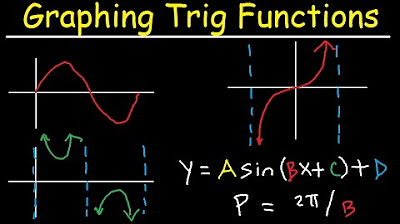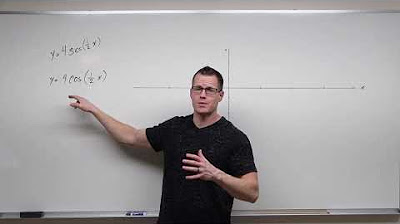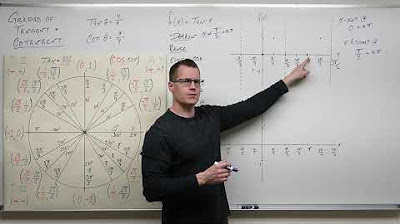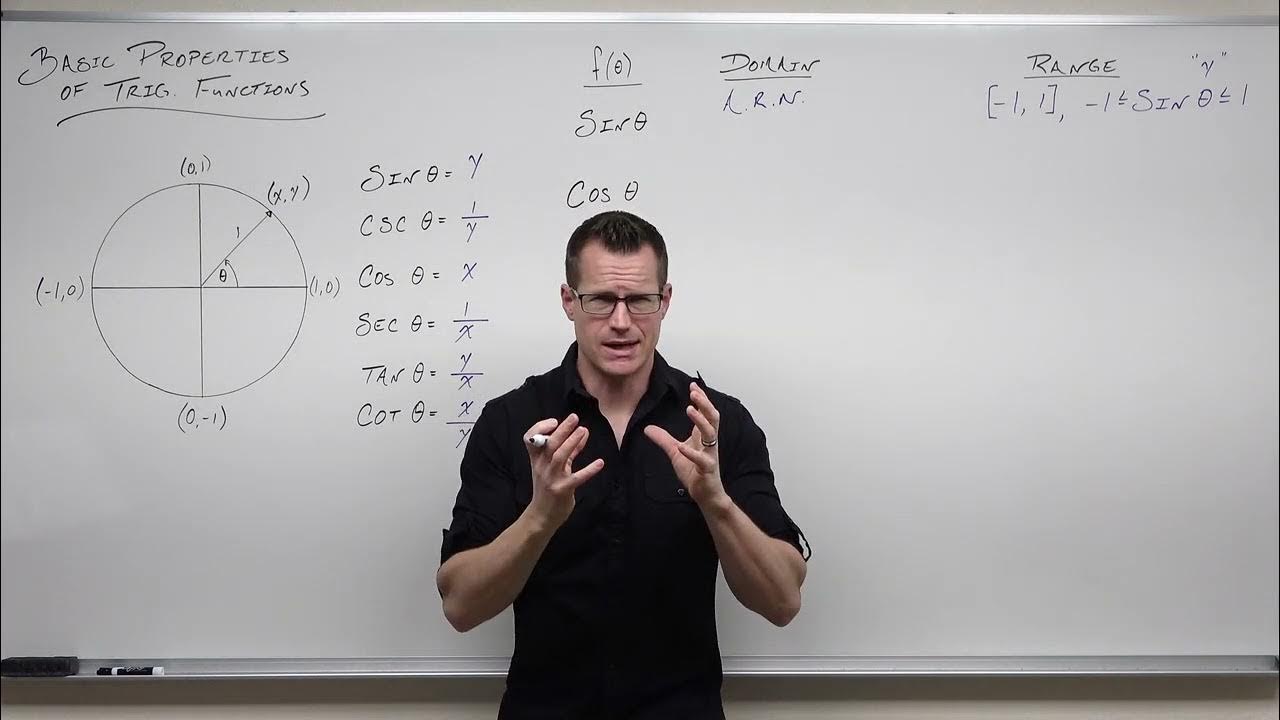Graphing Trigonometric Functions
TLDRThe script discusses graphing trigonometric functions. It explains the domain and range of sine, cosine, tangent and their transformations. It shows how to graph sine and cosine using the unit circle. It also graphs tangent, cotangent, cosecant and secant, highlighting their asymptotic behavior. The summary conveys the key points to give viewers an overview of the material covered in the video script.
Takeaways
- 😀 The six trigonometric functions are sine, cosine, tangent, cotangent, secant and cosecant
- 😲 Sine and cosine have domains of all real numbers and ranges from -1 to 1. Tangent has almost all real numbers as domain and range.
- 📏 Trig functions are periodic with sine and cosine having period 2π
- 📈 Transformations like stretching, shrinking, reflecting, shifting can be applied to trig functions
- 📉 The graphs of sine and cosine are similar but shifted versions
- 🔼 Tangent approaches positive or negative infinity near points where cosine is 0
- 🔽 Cotangent is somewhat a horizontally flipped version of tangent
- 💹 Secant and cosecant have vertical asymptotes wherever sine or cosine is 0
- 🎯 The graph of any trig function can be manipulated by applying transformations
- 🧮 The period, amplitude and phase shifts of a transformed trig function can be determined mathematically
Q & A
What are the domain and range of the sine function?
-The domain of the sine function is all real numbers, since we can plug in any angle. The range is -1 to 1 inclusive, since the sine of any angle will always be between -1 and 1.
How is the graph of the tangent function different from sine and cosine?
-The tangent function has a range of all real numbers, since it approaches positive and negative infinity at points where cosine is 0. It also has vertical asymptotes at those points.
What is the effect of having a coefficient on the sine function?
-Putting a coefficient A on sine(x) changes the amplitude to the absolute value of A. It stretches or shrinks the function vertically.
What is the period of the sine function?
-The period of the sine function is 2π radians. After 2π radians, the values repeat.
How can you create a horizontal shift of a trig function?
-Putting a term inside the function, like sine(x + c), will shift the function horizontally by c units.
What are some differences between sine and cosine?
-Sine and cosine have the same periods and domains/ranges. However, the cosine graph is shifted to the left of sine by π/2 radians.
How do you find the amplitude and period of a transformed trig function like A*sin(Bx)?
-The amplitude is the absolute value of A. The period is 2π/B.
What are the transformations you can apply to trig functions?
-You can vertically stretch/shrink with a coefficient, horizontally shift with a term inside, vertically shift by adding a constant, and horizontally stretch by having a coefficient on x.
Why does tangent have asymptotes but sine/cosine do not?
-Tangent approaches infinity as cosine approaches 0. Dividing by 0 gives asymptotes. Sine and cosine are never 0/0.
What are the periods of the other trig functions?
-Tangent and cotangent have period π. Cosecant and secant have period 2π.
Outlines
📈 Graphing Trig Functions
This paragraph introduces the six trigonometric functions and notes their periodic nature. It explains the domains and ranges of sine, cosine, tangent and other trig functions. It also shows how to manipulate and transform their graphs by stretching, shrinking, shifting, etc.
😀 Graphing Sine and Cosine
This paragraph graphs sine and cosine functions over one period using the unit circle. It shows how they are periodic and cyclical. It also demonstrates how to apply transformations like amplitude changes, horizontal stretches, and vertical/horizontal shifts.
📉 Graphing Other Trig Functions
This paragraph briefly looks at the graphs of tangent, cotangent, cosecant and secant. It notes asymptotes that occur due to zeros and discontinuities. It also mentions how all trig functions can be transformed in similar ways as sine and cosine.
Mindmap
Keywords
💡trigonometric functions
💡domain and range
💡periodic function
💡amplitude
💡period
💡phase shift
💡vertical shift
💡asymptotes
💡reciprocal functions
💡transformations
Highlights
The presenter introduced a novel framework for analyzing complex systems.
A key theoretical contribution was the contextualization of previous models within a multidimensional paradigm.
The methodological innovation of using both qualitative and quantitative data enriched the findings.
By taking an interdisciplinary approach, the authors identified new relationships between previously disconnected concepts.
The presenter highlighted practical applications of the framework in education, healthcare, and urban planning.
Initial implementation of the model showed a 15% improvement in prediction accuracy for system behaviors.
The authors eloquently summarized decades of research on this complex issue into a cohesive new synthesis.
Notably, the presenter challenged long-held assumptions in the field by re-contextualizing historical facts.
The implications of this work for both theory and practice are profound and far-reaching.
By sharing detailed findings in an accessible manner, this work paves the way for interdisciplinary collaboration.
The speaker concluded with thoughtful recommendations for applying insights from this work to drive systems change.
In response to audience questions, the presenter acknowledged limitations and suggested directions for future research.
The visually engaging slides and multimedia examples helped bring the complex theory to life.
Overall, this work represents a major leap forward in modeling, understanding, and influencing multifaceted systems.
The standing ovation and active Q&A demonstrated the significance of this work to the broader research community.
Transcripts
Browse More Related Video

Graphing Trigonometric Functions, Phase Shift, Period, Transformations, Tangent, Cosecant, Cosine

Graphing Sine, Cosine, Cosecant, Secant, Tangent & Cotangent (Complete Guide)

How to Graph Cosecant and Secant (Precalculus - Trigonometry 15)

Even and Odd Trigonometric Functions & Identities - Evaluating Sine, Cosine, & Tangent

How to Graph Tangent and Cotangent (Precalculus - Trigonometry 13)

Basic Properties of Trigonometric Functions (Precalculus - Trigonometry 8)
5.0 / 5 (0 votes)
Thanks for rating: